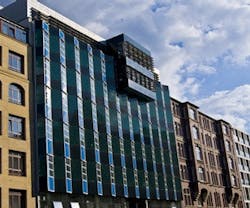Self-Cleaning Exterior Coatings
Self-cleaning exterior coatings are looming. Other countries around the world are using the technology already, and the United States has a lot to gain from looking at how these coatings perform.
The technology behind these coatings does two things:
- Causes water on the surface to form an even layer due to their hydrophilic nature, allowing dust and dirt to wash away.
- Breaks down organic substances when exposed to ultraviolet light (like the sun).
Containing titanium dioxide (TiO2), this self-cleaning coating was developed at the Singapore Institute of Manufacturing Technology (SIMTech), a research institute under A*STAR (Agency for Science, Technology and Research).
Although these coatings aren’t prevalent in the United States yet, the benefits being seen by other countries are worth examining:
- Reduced maintenance time and costs.
- Water savings.
- Increased life for the exterior of the building.
- Protection from dust, acid rain, and air pollution.
- Reduction of energy consumption for cooling the building.
- Reduction in mildew growth.
These coatings are designed specifically to reduce the frequency of washes necessary for the exterior of a building and, correspondingly, to drive down the cost of building maintenance. Because water is also saved in the process (the technology makes use of rainwater and doesn’t require any water beyond that), the coatings are also environmentally friendly. Strong detergents, scrubbing, wiping, and high-pressure water jets aren’t necessary, either, which extends the life of building exteriors. These items can cause damage to, and extra wear-and-tear on, the exterior of the building.
In Singapore (where the coating is currently being used), the surface of a typical commercial building is washed at least once a year. For some facilities, including shopping malls, exterior washing occurs as frequently as once a quarter. Every wash costs between $7,000 and $40,000, depending on the size of the building.
TiO2-coated tile and glass are also growing in terms of commercial use and offer the same benefits.
The bottom line: With this new coating technology, the surfaces of your clients’ buildings will remain cleaner longer and with less hassle.
